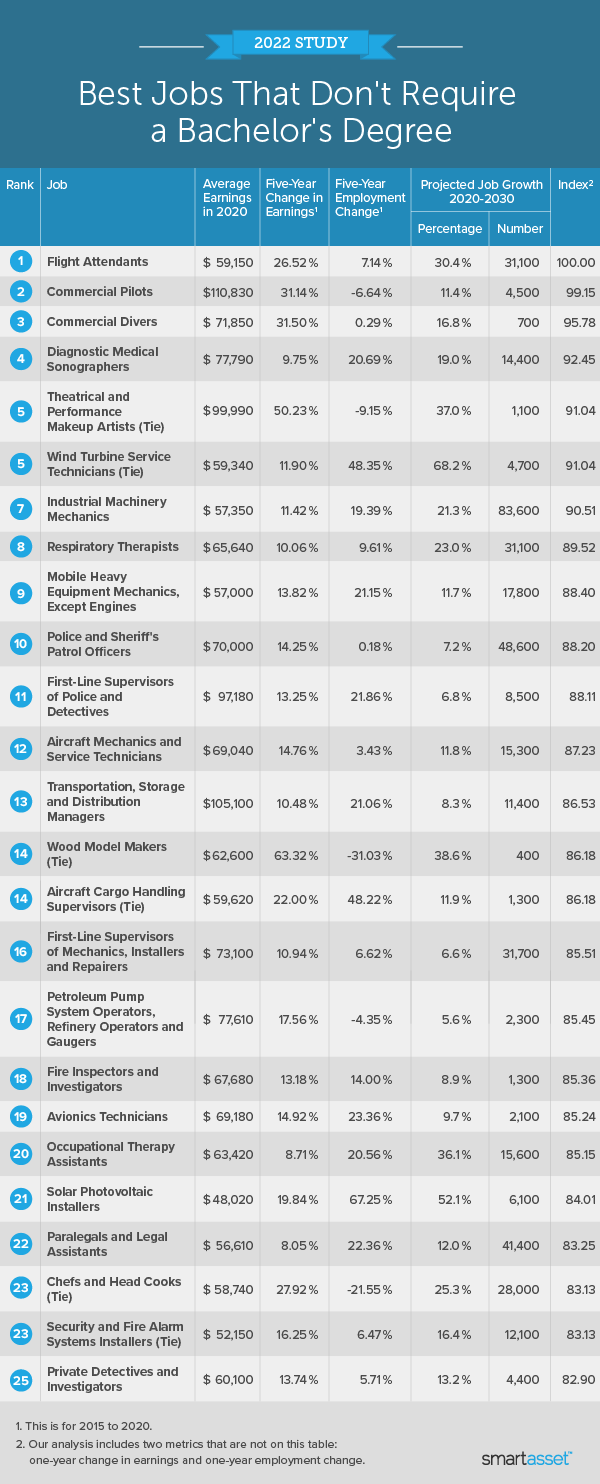In 2019, the Census Bureau reported that just 32% of the population ages 25 and older has a bachelor’s degree. With 216.1 million people aged 25 and older in the United States, that leaves 147 million without a college degree.
Keeping this in mind, SmartAsset identified the jobs that don’t require a bachelor’s degree. To do so, we examined Bureau of Labor Statistics (BLS) data from 413 professions and compared them across the following seven metrics: average annual salary in 2020, one- and five-year changes in earnings, one- and five-year changes in employment, 10-year expected percentage growth in employment and 10-year expected growth in number of workers. For details on our data sources and how we put all the information together for our final rankings, read the Data and Methodology section below.
Key Findings
- Workers in the top 10 jobs earn $57,000 or more. Average earnings for workers in the top 10 jobs are higher than average earnings across all occupations ($56,310). Within the top 10, mobile heavy equipment mechanics have the lowest average earnings ($57,000) and commercial pilots have the highest average earnings ($110,830).
- Remote opportunities are few and far between. The majority of the jobs at the top of our list required an in-person component. However, there are opportunities for at least partial remote work, such as respiratory therapists and diagnostic medical sonographers.
- Aviation-related jobs dominated the top 20 spots. Five out of the top 20 jobs in our ranking are in the aviation sector with the top two spots being claimed by flight attendants and commercial pilots, respectively. Commercial pilots also ranked second out of all the occupations we analyzed for highest average salary. Post-pandemic, the aviation industry looks to bounce back with a projected upswing in job growth over the next 10 years, with at least a 9% projected workforce growth.

1. Flight Attendants
Flight attendants, who provide service and handle safety situations to ensure the comfort of passengers, rank first in SmartAsset’s study for jobs that don’t require a bachelor’s degree. According to the BLS, this occupation is projected to experience 30% job growth over the next 10 years. In terms of salary, flight attendants averaged $59,150 annually and rank 17th for earnings growth over the past five years (26.5%).
2. Commercial Pilots
Commercial pilots fly and navigate aircrafts including helicopters and airplanes. While their counterparts (airline pilots) may require a bachelor’s degree, commercial pilots may only need to complete on-the-job training. This job was also one of only four jobs in our study that the BLS reported earning over $100,000 annually on average, ranking second in this category on our list. There was a 7.74% growth in earnings from 2019 to 2020. Looking back further, the percentage change in earnings from 2015 to 2020 was even higher at 31.10% (10th-highest in our study).
3. Commercial Divers
Commercial divers work in water to complete a variety of tasks including but not limited to installing or maintaining equipment or structures located under the surface, working with explosives, and photographing marine life. According to the BLS, the average annual salary for commercial divers was $71,850. In our ranking, commercial divers placed 17th for one year earnings growth from 2019 to 2020 and ninth for earnings growth from 2015 to 2020.
4. Diagnostic Medical Sonographers
Diagnostic medical sonographers produce ultrasounds of patients for physicians. On average, the BLS reports that those in this field could expect to earn $77,790 annually on average. In the past five years, this field grew nearly 10% in earnings. In the past five years, employment numbers grew by 20.69% and are projected by the BLS to grow another 19% by 2030.
5. Makeup Artists, Theatrical and Performance
Makeup artists apply cosmetics to performers. This profession ranked in the top 10 for four metrics: 2020 average annual salary ($99,990), one-year earnings growth (22.54%), five-year earnings growth (50.23%) and 10-year employment growth projections (37%).
6. Wind Turbine Service Technicians
Wind turbine service technicians install, monitor, maintain and repair wind turbines. They are also known as windtechs. According to the BLS, the average annual salary was $59,340 in 2020. Earnings grew by 11.90% over the past five years. In our analysis, this field ranked second for projected 10-year employment growth. That would be a 68.20% increase in employment by 2030.
7. Industrial Machinery Mechanics
Industrial machinery mechanics, also known as maintenance machinists, are tasked with installing, maintaining and repairing industrial machinery. The BLS projects there will be 83,600 more industrial machinery mechanic workers in 2030 than there were in 2020, a 21.30% increase. Those working in this field can expect an average annual salary of $57,350. Looking back, annual salaries for industrial machinery mechanics grew by 11.42% over the past five years.
8. Respiratory Therapists
Respiratory therapists are medical practitioners that specialize in healthcare for patients suffering from respiratory conditions and diseases such as trouble breathing, asthma, cardiac arrest and more. The average annual salary was $65,640 in 2020 according to the BLS. The federal agency also projects an employment growth rate of 23% by 2030.
9. Mobile Heavy Equipment Mechanics, Except Engines
Mobile heavy equipment mechanics work with mechanical, hydraulic and pneumatic equipment and machinery such as bulldozers, cranes, conveyor belts, etc. They are primarily tasked with maintenance and repair. Earnings increased by 13.82% and employment numbers expanded by 21.15% from 2015. For the future, the BLS projects a 11.70% increase in employment over the next 10 years.
10. Police and Sheriff’s Patrol Officers
Police and sheriff’s patrol officers are tasked with general law enforcement duties such as maintaining law and order, and are the most recognizable type of law enforcement. In 2020, the BLS reported an average annual salary of $70,000 for this field. Earnings since 2015 have increased by 14.25%. The federal agency also projects an increase in employment numbers of 7.20% or roughly 48,600 police and sheriff’s patrol officers by 2030.
Data and Methodology
To find the best jobs that don’t require a bachelor’s degree, SmartAsset looked at occupation data from the Bureau of Labor Statistics. We sorted occupations by the typical degree needed for entry, filtering out any occupation with “all other” or “miscellaneous” in the title due to lack of specificity. We compared the remaining 413 occupations across seven metrics:
- Average annual salary. Data comes from the Bureau of Labor Statistics’ Occupational Employment and Wage Statistics and is for May 2020.
- One-year percentage change in earnings. Data comes from Bureau of Labor Statistics’ Occupational Employment and Wage Statistics and is for May 2019 and May 2020.
- Five-year percentage change in earnings. Data comes from Bureau of Labor Statistics’ Occupational Employment and Wage Statistics and is for May 2015 and May 2020.
- One-year percentage change in employment. Data comes from Bureau of Labor Statistics’ Occupational Employment and Wage Statistics and is for May 2019 and May 2020.
- Five-year percentage change in employment. >Data comes from Bureau of Labor Statistics’ Occupational Employment and Wage Statistics and is for May 2015 and May 2020.
- 10-year expected percentage growth in employment. This is the projected percentage change in the number of people employed in an occupation from 2020 to 2030. Data comes from the Bureau of Labor Statistics’ 2020 Employment Projections.
- 10-year expected growth in the number of workers. This is the projected gross change in the number of people employed in an occupation from 2020 to 2030. Data comes from the Bureau of Labor Statistics’ 2020 Employment Projections.
We ranked each city in each metric, double weighting average annual salary and half weighting four metrics: one-year percentage change in earnings, five-year percentage change in earnings, one-year percentage change in employment, and five-year percentage change in employment. All other metrics were single weighted. We then found each occupation’s average ranking and used that to determine a final score. The occupation with the best average ranking received a score of 100 while the occupation with the worst average ranking received a score of 0.
Financial Planning Tips
- A financial advisor can help you plan your finances. SmartAsset’s free tool matches you with up to three financial advisors in your area, and you can interview your advisor matches at no cost to decide which one is right for you. If you’re ready to find an advisor who can help you achieve your financial goals, get started now.
- One key to financial planning is knowing how much you’ll have to put in the bank. SmartAsset’s paycheck calculator will help you figure out what your take home pay will be.
Questions about our study? Contact press@smartasset.com.
Photo credit: © iStock/Chalabala
